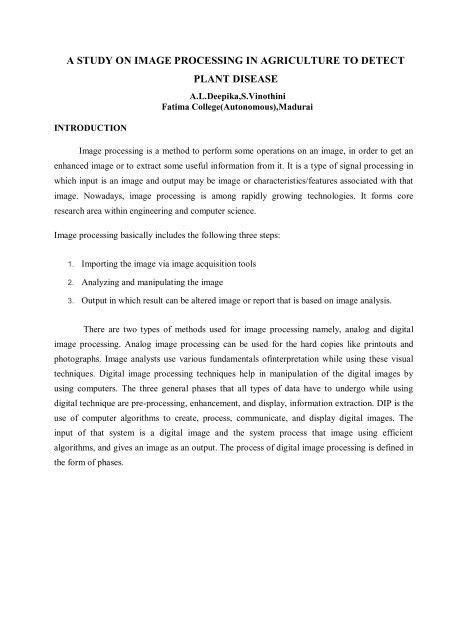combinepdf (5)
You also want an ePaper? Increase the reach of your titles
YUMPU automatically turns print PDFs into web optimized ePapers that Google loves.
A STUDY ON IMAGE PROCESSING IN AGRICULTURE TO DETECT<br />
INTRODUCTION<br />
PLANT DISEASE<br />
A.L.Deepika,S.Vinothini<br />
Fatima College(Autonomous),Madurai<br />
Image processing is a method to perform some operations on an image, in order to get an<br />
enhanced image or to extract some useful information from it. It is a type of signal processing in<br />
which input is an image and output may be image or characteristics/features associated with that<br />
image. Nowadays, image processing is among rapidly growing technologies. It forms core<br />
research area within engineering and computer science.<br />
Image processing basically includes the following three steps:<br />
1. Importing the image via image acquisition tools<br />
2. Analyzing and manipulating the image<br />
3. Output in which result can be altered image or report that is based on image analysis.<br />
There are two types of methods used for image processing namely, analog and digital<br />
image processing. Analog image processing can be used for the hard copies like printouts and<br />
photographs. Image analysts use various fundamentals ofinterpretation while using these visual<br />
techniques. Digital image processing techniques help in manipulation of the digital images by<br />
using computers. The three general phases that all types of data have to undergo while using<br />
digital technique are pre-processing, enhancement, and display, information extraction. DIP is the<br />
use of computer algorithms to create, process, communicate, and display digital images. The<br />
input of that system is a digital image and the system process that image using efficient<br />
algorithms, and gives an image as an output. The process of digital image processing is defined in<br />
the form of phases.




